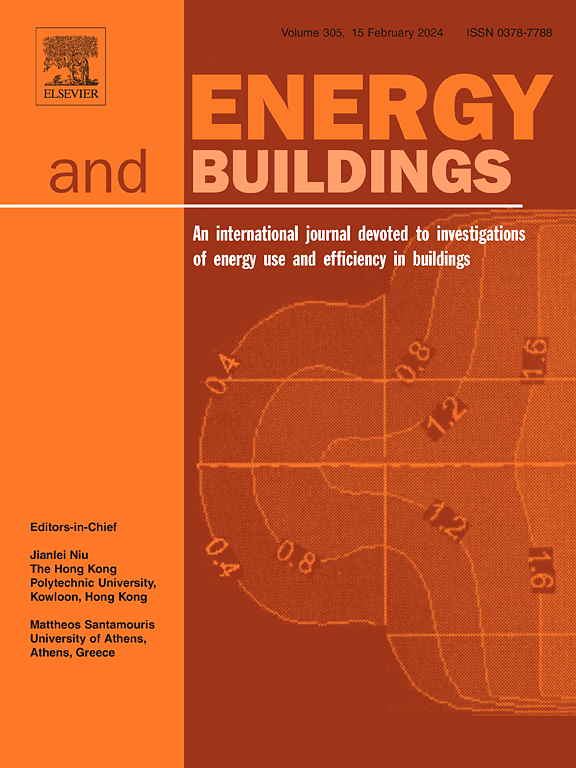Capturing available solar energy on urban-scale building surface: A multi-dimensional perspective
IF 6.6
2区 工程技术
Q1 CONSTRUCTION & BUILDING TECHNOLOGY
引用次数: 0
Abstract
The available solar energy on urban building surfaces is essential for the energy transformation. Many cities have installed building photovoltaic, but it has not fully exploited the potential of the building surface. Based on geographic information and open-source meteorological data, the methodology employs the Radiance simulation engine to generate multi-condition sky luminance distribution matrices. Through spatial partitioning of the buildings into thousands of clusters based on Area of Interest, the analysis evaluates shading impacts at building level. The calculation results deconstruct the complex solar radiation condition on urban-scale buildings from a multi-dimensional perspective (space, time, solar radiation types) to maximize solar energy utilization. The findings indicate that: (1) Building surfaces in Hangzhou capture 1.74 × 1011 kWh of global solar radiation each year, with roofs and facades accounting for 54 % and 46 %. The roof and southern facades offer excellent opportunities for solar energy utilization. (2) 1.41 × 1011 kWh of global solar radiation each year meets the usage criteria with a direct-to-diffuse ratio of 0.8. The solar power potential of building surfaces is estimated at 1.99 × 1010 kWh, which fulfill 28 % of the city’s annual electricity demand, with greater generation capacity during summer. (3) The levelized cost of electricity of different plans demonstrate that prioritizing rooftop photovoltaic deployment yields optimal economic returns, followed by southern facades. Leveraging the technical and economic potential, it is recommended that policymakers continue rooftop photovoltaic development, advance southern photovoltaic, explore pilot projects for eastern and western photovoltaic. The study provides actionable strategies to further exploit photovoltaic potential, evidencing solar energy’s crucial role in facilitating urban energy transitions and advancing sustainable development goals.
在城市尺度的建筑表面捕捉可用的太阳能:多维视角
城市建筑表面可利用的太阳能对于能量转换至关重要。许多城市已经安装了建筑光伏,但它并没有充分发挥建筑表面的潜力。该方法基于地理信息和开源气象数据,利用Radiance模拟引擎生成多条件天空亮度分布矩阵。通过基于兴趣区域将建筑空间划分为数千个集群,分析评估了建筑层面的遮阳影响。计算结果从多维度(空间、时间、太阳辐射类型)的角度解构城市尺度建筑上复杂的太阳辐射状况,最大限度地利用太阳能。结果表明:(1)杭州市建筑表面每年捕获全球太阳辐射1.74 × 1011 kWh,其中屋顶和外立面分别占54%和46%。屋顶和南立面为太阳能的利用提供了极好的机会。(2)每年全球太阳辐射1.41 × 1011 kWh,直漫比为0.8,满足使用标准。建筑表面的太阳能潜力估计为1.99 × 1010千瓦时,满足城市年电力需求的28%,夏季的发电能力更大。(3)不同方案的平准化电力成本表明,优先部署屋顶光伏具有最优的经济效益,其次是南立面。利用技术和经济潜力,建议决策者继续发展屋顶光伏,推进南部光伏,探索东部和西部光伏试点项目。该研究为进一步开发光伏潜力提供了可行的策略,证明了太阳能在促进城市能源转型和推进可持续发展目标方面的关键作用。
本文章由计算机程序翻译,如有差异,请以英文原文为准。
求助全文
约1分钟内获得全文
求助全文
来源期刊

Energy and Buildings
工程技术-工程:土木
CiteScore
12.70
自引率
11.90%
发文量
863
审稿时长
38 days
期刊介绍:
An international journal devoted to investigations of energy use and efficiency in buildings
Energy and Buildings is an international journal publishing articles with explicit links to energy use in buildings. The aim is to present new research results, and new proven practice aimed at reducing the energy needs of a building and improving indoor environment quality.
 求助内容:
求助内容: 应助结果提醒方式:
应助结果提醒方式:


